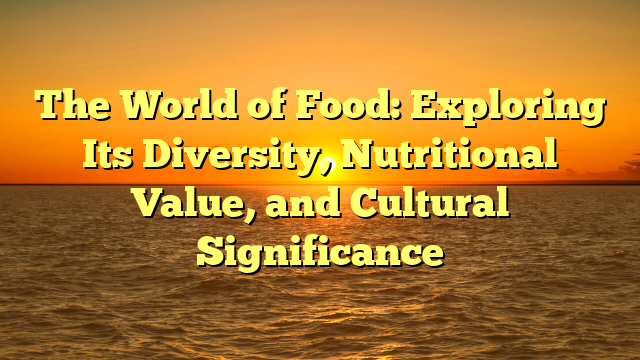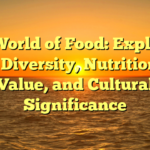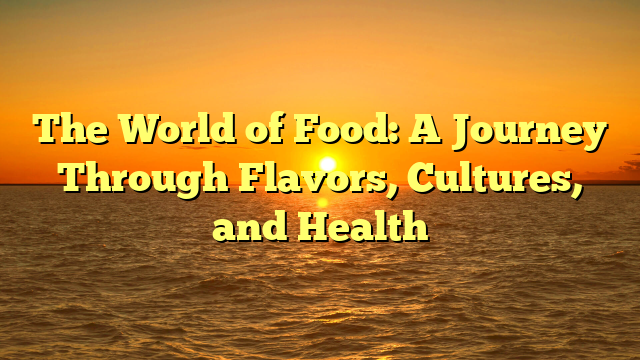Food is much more than a necessity for survival. It is a universal language, a form of art, and an integral part of every culture and society across the globe. The diversity in food, its preparation, and the meanings it carries go beyond taste and nutrition. It is a social and cultural experience that brings people together and shapes our daily lives. In this article, we will explore the various aspects of food—its nutritional value, cultural importance, and the vast range of global cuisine.
The Nutritional Value of Food
At its core, food serves as a source of energy and nourishment for the human body. It provides the essential nutrients we need to maintain health and well-being. These nutrients include carbohydrates, proteins, fats, vitamins, and minerals, each of which plays a specific role in our bodily functions.
Carbohydrates are the body’s primary source of energy. They are found in foods like rice, bread, pasta, fruits, and vegetables. Simple carbohydrates, such as sugars, are easily digested and provide quick energy, while complex carbohydrates, found in whole grains, provide longer-lasting energy.
Proteins are essential for the growth and repair of tissues. They are made up of amino acids, some of which our body cannot produce on its own and must obtain through food. Meat, fish, eggs, legumes, and nuts are all rich sources of protein.
slot bonus new member are often misunderstood but are vital to our health. They support cell function, protect organs, and aid in the absorption of fat-soluble vitamins like A, D, E, and K. Healthy fats, such as those found in olive oil, avocados, and nuts, are crucial for overall health.
Vitamins and minerals are essential in small amounts but play a significant role in maintaining bodily functions. For example, vitamin C boosts the immune system, calcium strengthens bones, and iron helps in transporting oxygen through the blood.
Water, though often overlooked, is one of the most critical elements in food. The human body is made up of about 60% water, and it is essential for nearly every bodily function, from digestion to temperature regulation.
The Diversity of Global Cuisine
Food is a cornerstone of culture, and every region in the world has developed its unique culinary traditions over thousands of years. From the spicy curries of India to the fresh sushi of Japan, food reflects the history, geography, and customs of the people who prepare it.
Asian Cuisine is perhaps one of the most diverse in the world. Countries like China, Japan, India, Thailand, and Vietnam offer a wide range of flavors and techniques. In China, for instance, you’ll find a focus on balance and harmony in dishes, often combining sweet, sour, salty, and bitter flavors. In Japan, sushi is revered for its simplicity and precision, emphasizing the freshness of ingredients. Indian cuisine, with its rich array of spices, creates complex, aromatic dishes like curry, biryani, and dosa.
Mediterranean Cuisine is known for its emphasis on fresh vegetables, olive oil, fish, and grains. Countries bordering the Mediterranean Sea, such as Greece, Italy, and Spain, have shaped the region’s culinary identity. The Mediterranean diet is considered one of the healthiest in the world, with an abundance of heart-healthy fats, antioxidant-rich vegetables, and lean proteins. Dishes like Greek salad, pasta, paella, and hummus showcase the region’s diversity and health benefits.
Latin American Cuisine brings together a blend of indigenous, African, and European influences. From Mexico’s tacos and enchiladas to Brazil’s feijoada and Argentina’s steaks, Latin American food is vibrant, flavorful, and often a celebration of community. Staples like corn, beans, and rice are found throughout the region, with chili peppers adding spice and character to many dishes.
European Cuisine offers an equally diverse range of dishes, from the hearty stews and sausages of Germany and France to the delicate pastries and sauces of France and Italy. British food, while often considered bland, is comfort-oriented, with dishes like fish and chips and shepherd’s pie providing a sense of nostalgia and warmth. French cuisine, on the other hand, is known for its emphasis on technique and refinement, exemplified in dishes like coq au vin and escargot.
The Cultural Significance of Food
Beyond its nutritional benefits, food plays a central role in cultural identity. Food rituals and traditions often mark important life events, celebrations, and holidays.
Cultural Identity and Traditions: Food is often tied to one’s heritage, and many cultures pass down recipes through generations. For example, Thanksgiving dinner in the United States is a time to gather with family and friends to celebrate the harvest and share traditional foods like turkey, stuffing, and pumpkin pie. In Italy, Sunday meals are a family affair, often consisting of multiple courses, from antipasto to pasta, to meat, and dessert. Food is a way to preserve history and create a sense of belonging.
Religious Celebrations: Many religions have specific food rituals and practices tied to religious observances. For example, in Judaism, the Passover meal includes symbolic foods such as matzah and bitter herbs, while in Christianity, the act of communion involves bread and wine. In Islam, fasting during the month of Ramadan is a time for spiritual reflection, with Iftar marking the breaking of the fast with dates, water, and a hearty meal.
Socializing and Bonding: In many cultures, sharing food is an important social activity. Meals bring people together, creating opportunities for conversation, laughter, and connection.
Whether it’s gathering around a BBQ in the United States, sharing tapas in Spain, or enjoying a tea ceremony in Japan, food has the power to unite people and foster community.
The Future of Food
As the global population grows and the world changes, food production faces new challenges. Sustainability, climate change, and food security are all pressing issues that must be addressed to ensure that future generations can enjoy the same variety and nutritional value that food offers today.
Innovations in agriculture, such as vertical farming and lab-grown meat, are being explored to meet the growing demand for food in a more sustainable way. Meanwhile, there is a growing focus on plant-based diets as a way to reduce environmental impact and improve health outcomes. In the years to come, technology will likely continue to shape how we grow, prepare, and consume food.
Conclusion
Food is far more than sustenance; it is a reflection of our culture, history, and values. It nourishes the body and the soul, connecting us to others in ways that go beyond mere survival. From the humble potato to the exquisite flavors of gourmet cuisine, food has the power to inspire, unite, and sustain us in every aspect of our lives. As we move forward, it is essential to continue appreciating the diversity, nutritional value, and cultural significance that food holds in our world.
The World of Food: Exploring Its Diversity, Nutritional Value, and Cultural Significance










